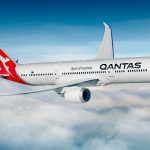
Qantas, British Airways, KLM, Lufthansa, Malaysia Airlines and Singapore Airlines are among airlines to have adjusted their flight paths to avoid a risky area of the Middle East, after an Iranian missile shot a large US military surveillance drone out of the sky in close proximity to passenger aircraft.
Qantas announced the route change on Friday, saying the change would remain in place until further notice. FlightAware.com tracking shows that QF9, the Qantas nonstop service from Perth to London Heathrow, passed routinely through Iranian airspace earlier last week, but the flight path has now been moved southwest to skirt Iranian airspace. The effect on flight time should be minimal.
The US Federal Aviation Administration (FAA) on Friday banned US carriers from flying over parts of the Gulf within the Tehran Flight Information Region, a block of airspace that extends into the Gulf, covering half of the Strait of Hormuz between Iran and the UAE and extending to the northern half of the Gulf of Oman.
The FAA warned that many civilian aircraft were flying in the area when Iran shot down the US surveillance drone.
It stated:
“The risk to U.S. civil aviation is demonstrated by the Iranian surface-to-air missile shoot down of a U.S. unmanned aircraft system on 19 June 2019 while it was operating in the vicinity of civil air routes above the Gulf of Oman.”
A month ago, the FAA warned its commercial airlines of the same risk, saying Iran could mistake passenger planes for military aircraft. See: US issues chilling warning to airlines flying over Gulf
British Airways said at the weekend it would avoid flying in airspace controlled by Iran, Britain’s Independent reported.

Qantas 787-9 Dreamliner operates QF9 nonstop Perth-London
The same news outlet also quoted an Emirates spokesman saying: “In light of the current situation, Emirates has taken precautionary measures including rerouting all flights away from areas of possible conflict.
“The re-routings have minimally affected the arrival/departure timings of some flights.”
AFP news agency quoted Abu Dhabi-based Etihad saying it had “agreed to change a number of the flight paths we operate to and from the Arabian Gulf”.
![]()
BEFORE: FlightAware tracking shows flightpath of QF9 Perth-London passing through Iranian airspace
Qatar Airways is particularly affected by the crisis. It has been under pressure since neighbouring countries such as Saudi Arabia banned its overflights to make a point in one of the Middle East’s seemingly eternal disputes.
Airlines are acutely aware that in July 2014, Malaysia Airlines flight MH17 was shot down while flying over a war zone in a disputed part of the Ukraine, killing all 298 aboard. For the latest on that, see: New light shines on notorious two Malaysia Airlines crashes
![]()
AFTER: FlightAware tracking shows flightpath of QF9 Perth-London skirting to the south of Iranian airspace
The Strait of Hormuz was, 31 years ago, the site of an earlier catastrophe over hostile territory, producing a death toll nearly as high as that of Malaysia Airlines flight MH17. An Airbus A300 making a scheduled passenger flight across the Persian Gulf from Tehran to Dubai was shot down on 3 July 1988.

FlightRadar24 shows air traffic passing south of Iran yesterday
In that incident, Iran Air flight IR 655 was hit by a surface-to-air missile fired from the US Navy guided missile cruiser USS Vincennes. The warship apparently mistook the unarmed passenger plane on radar for a hostile fighter jet. The missile blew flight IR 655 out of the air, killing all 290 people aboard, including 66 children.
IR 655 was shot down over the Strait of Hormuz, the same area now affected by the FAA flight ban.

Nuclear-powered aircraft carrier USS Abraham Lincoln, currently deployed in the Middle East
Written by Peter Needham
















